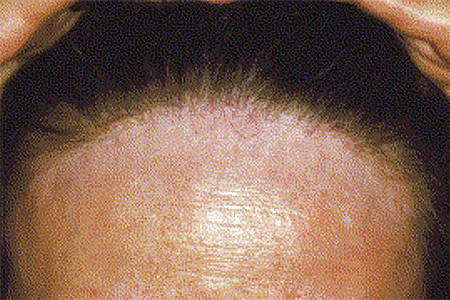Hair loss types: Frontal fibrosing alopecia overview
Frontal fibrosing alopecia
What is frontal fibrosing alopecia?
The medical name for hair loss is “alopecia.” Frontal fibrosing alopecia is a specific type of hair loss. It destroys the hair follicles (openings out of which hair grows), causing permanent hair loss. With an early diagnosis and medical treatment, it’s possible to stop the disease from progressing and causing further permanent hair loss.
Is frontal fibrosing alopecia contagious? No
Frontal fibrosing alopecia (FFA) tends to start slowly, often causing a thin band of balding skin that runs along the front and sides of the hairline.
FFA can also cause hair loss elsewhere on the body. Anywhere you have hair, you may notice hair loss. Many people lose some (or all) of their eyebrows. As the hair loss advances, some people lose pubic hair, underarm hair, or hair on their arms or legs. People with facial hair may notice less hair in their beard area.
FFA usually begins during menopause (have not had a period for at least one year). Most people say they’ve noticed hair loss for about two to 12 years after they start menopause. FFA can also begin earlier in life.
Frontal fibrosing alopecia (early)
This type of hair loss often looks like a receding hairline that runs along the front and sides of your head.

The first noticeable sign of FFA is often noticeable loss of eyebrow hairs. Between 80% and 95% of women diagnosed with FFA have lost some (or all) of their eyebrows.
Without medical treatment, FFA often causes permanent hair loss that covers a larger area with each passing year. That receding hairline which was once barely noticeable can become a bald band that reaches to the middle of the head — or even further back. This hair loss is permanent, so hair cannot regrow once lost.
The good news is that when caught early, medical treatment can stop further hair loss. The earlier someone gets diagnosed with FFA and starts treatment, the more effective treatment tends to be.
As FFA tends to develop slowly, it can be difficult to notice the earliest signs.
It’s also possible for FFA to cause hair loss that comes on rapidly rather than gradually. Some people develop patches of hair loss rather than a receding hairline.
You’ll find more information about the possible signs and symptoms along with pictures of FFA at: Frontal fibrosing alopecia: Signs and symptoms.
Image
Image used with permission of the Journal of the American Academy of Dermatology. (J Am Acad Dermatol 2005;52:55-60.)
References
Brandi N, Starace M, et al. “The doll hairline: A clue for the diagnosis of frontal fibrosing alopecia.” J Am Acad Dermatol. 2017;77(5):e127-8.
Imhof R, Tolkachjov SN. “Optimal management of frontal fibrosing alopecia: A practical guide.” Clin Cosmet Investig Dermatol. 2020;13:897-910.
Mirmirani P, Tosti A, et al. “Frontal fibrosing alopecia: An emerging epidemic.” Skin Appendage Disord 2019;5:90-3.
Tosti A, Piraccini BM, et al. “Frontal fibrosing alopecia in postmenopausal women.” J Am Acad Dermatol. 2005;52:55-60.
Strazzulla LC, Avila L, et al. “Prognosis, treatment, and disease outcomes in frontal fibrosing alopecia: A retrospective review of 92 cases.” [reserch letter] J Am Acad Dermatol. 2018;78:203-4.
Vano-Galvan S, Molina-Riuz AM, et al. “Frontal fibrosing alopecia: A multicenter review of 355 patients.” J Am Acad Dermatol. 2014;70:670–8.
Written by:
Paula Ludmann, MS
Reviewed by:
Shani Francis, MD, MBA, FAAD
Elena B. Hawryluk, MD, PhD, FAAD
Carrie L. Kovarik, MD, FAAD
William W. Kwan, MD, FAAD
Shari Lipner, MD, PhD, FAAD
Last updated: 8/18/21
 Think sun protection during Skin Cancer Awareness Month
Think sun protection during Skin Cancer Awareness Month
 How to care for your skin if you have lupus
How to care for your skin if you have lupus
 Practice Safe Sun
Practice Safe Sun
 Sunscreen FAQs
Sunscreen FAQs
 Fade dark spots
Fade dark spots
 Hidradenitis suppurativa
Hidradenitis suppurativa
 Laser hair removal
Laser hair removal
 Scar treatment
Scar treatment
 Botox
Botox
 Kids' camp - Camp Discovery
Kids' camp - Camp Discovery
 Dermatologist-approved lesson plans, activities you can use
Dermatologist-approved lesson plans, activities you can use
 Find a Dermatologist
Find a Dermatologist
 Why choose a board-certified dermatologist?
Why choose a board-certified dermatologist?